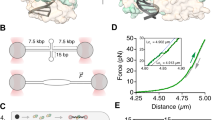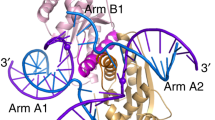Abstract
Holliday junction (HJ) resolution by resolving enzymes is essential for chromosome segregation and recombination-mediated DNA repair. HJs undergo two types of structural dynamics that determine the outcome of recombination: conformer exchange between two isoforms and branch migration. However, it is unknown how the preferred branch point and conformer are achieved between enzyme binding and HJ resolution given the extensive binding interactions seen in static crystal structures. Single-molecule fluorescence resonance energy transfer analysis of resolving enzymes from bacteriophages (T7 endonuclease I), bacteria (RuvC), fungi (GEN1) and humans (hMus81-Eme1) showed that both types of HJ dynamics still occur after enzyme binding. These dimeric enzymes use their multivalent interactions to achieve this, going through a partially dissociated intermediate in which the HJ undergoes nearly unencumbered dynamics. This evolutionarily conserved property of HJ resolving enzymes provides previously unappreciated insight on how junction resolution, conformer exchange and branch migration may be coordinated.
This is a preview of subscription content, access via your institution
Access options
Access Nature and 54 other Nature Portfolio journals
Get Nature+, our best-value online-access subscription
$29.99 / 30 days
cancel any time
Subscribe to this journal
Receive 12 print issues and online access
$259.00 per year
only $21.58 per issue
Buy this article
- Purchase on Springer Link
- Instant access to full article PDF
Prices may be subject to local taxes which are calculated during checkout





Similar content being viewed by others
Code availability
All custom software and codes are available from the corresponding authors on request or can be downloaded from the Ha Research Group website at http://ha.med.jhmi.edu/resources/.
Data availability
The data that support the findings of this study are available from the corresponding authors upon reasonable request.
References
Liu, Y. & West, S. C. Happy Hollidays: 40th anniversary of the Holliday junction. Nat. Rev. Mol. Cell Biol. 5, 937–944 (2004).
Lilley, D. M. Structures of helical junctions in nucleic acids. Q. Rev. Biophys. 33, 109–159 (2000).
Lilley, D. M. & White, M. F. The junction-resolving enzymes. Nat. Rev. Mol. Cell Biol. 2, 433–443 (2001).
Déclais, A. C. & Lilley, D. M. New insight into the recognition of branched DNA structure by junction-resolving enzymes. Curr. Opin. Struct. Biol. 18, 86–95 (2008).
Wyatt, H. D. & West, S. C. Holliday junction resolvases. Cold Spring Harb. Perspect. Biol. 6, a023192 (2014).
Sarbajna, S. & West, S. C. Holliday junction processing enzymes as guardians of genome stability. Trends. Biochem. Sci. 39, 409–419 (2014).
Karymov, M., Daniel, D., Sankey, O. F. & Lyubchenko, Y. L. Holliday junction dynamics and branch migration: single-molecule analysis. Proc. Natl Acad. Sci. USA 102, 8186–8191 (2005).
McKinney, S. A., Freeman, A. D., Lilley, D. M. & Ha, T. Observing spontaneous branch migration of Holliday junctions one step at a time. Proc. Natl Acad. Sci. USA 102, 5715–5720 (2005).
McKinney, S. A., Déclais, A. C., Lilley, D. M. J. & Ha, T. Structural dynamics of individual Holliday junctions. Nat. Struct. Biol. 10, 93–97 (2003).
Joo, C., McKinney, S. A., Lilley, D. M. J. & Ha, T. Exploring rare conformational species and ionic effects in DNA Holliday junctions using single-molecule spectroscopy. J. Mol. Biol. 341, 739–751 (2004).
Hohng, S. et al. Fluorescence-force spectroscopy maps two-dimensional reaction landscape of the Holliday junction. Science 318, 279–283 (2007).
Hadden, J. M., Déclais, A. C., Carr, S. B., Lilley, D. M. & Phillips, S. E. The structural basis of Holliday junction resolution by T7 endonuclease I. Nature 449, 621–624 (2007).
Biertümpfel, C., Yang, W. & Suck, D. Crystal structure of T4 endonuclease VII resolving a Holliday junction. Nature 449, 616–620 (2007).
Déclais, A. C. et al. The complex between a four-way DNA junction and T7 endonuclease I. EMBO J. 22, 1398–1409 (2003).
Górecka, K. M., Komorowska, W. & Nowotny, M. Crystal structure of RuvC resolvase in complex with Holliday junction substrate. Nucleic Acids Res. 41, 9945–9955 (2013).
Liu, Y. et al. Crystal structure of a eukaryotic GEN1 resolving enzyme bound to DNA. Cell Rep. 13, 2565–2575 (2015).
Ha, T. et al. Probing the interaction between two single molecules: fluorescence resonance energy transfer between a single donor and a single acceptor. Proc. Natl Acad. Sci. USA 93, 6264–6268 (1996).
Ha, T. Single-molecule approaches embrace molecular cohorts. Cell 154, 723–726 (2013).
Duckett, D. R. et al. The structure of the Holliday junction, and its resolution. Cell 55, 79–89 (1988).
Déclais, A. C., Hadden, J., Phillips, S. E. & Lilley, D. M. The active site of the junction-resolving enzyme T7 endonuclease I. J. Mol. Biol. 307, 1145–1158 (2001).
Duckett, D. R., Panis, M. J. & Lilley, D. M. Binding of the junction-resolving enzyme bacteriophage T7 endonuclease I to DNA: separation of binding and catalysis by mutation. J. Mol. Biol. 246, 95–107 (1995).
Liu, J., Déclais, A. C. & Lilley, D. M. Mechanistic aspects of the DNA junction-resolving enzyme T7 endonuclease I. Biochemistry 45, 3934–3942 (2006).
Kim, H. D. et al. Mg2+-dependent conformational change of RNA studied by fluorescence correlation and FRET on immobilized single molecules. Proc. Natl Acad. Sci. USA 99, 4284–4289 (2002).
Zhou, R. et al. SSB functions as a sliding platform that migrates on DNA via reptation. Cell 146, 222–232 (2011).
Freeman, A. D., Déclais, A. C. & Lilley, D. M. The importance of the N-terminus of T7 endonuclease I in the interaction with DNA junctions. J. Mol. Biol. 425, 395–410 (2013).
Bennett, R. J., Dunderdale, H. J. & West, S. C. Resolution of Holliday junctions by RuvC resolvase: cleavage specificity and DNA distortion. Cell 74, 1021–1031 (1993).
van Gool, A. J., Shah, R., Mézard, C. & West, S. C. Functional interactions between the holliday junction resolvase and the branch migration motor of Escherichia coli. EMBO J. 17, 1838–1845 (1998).
Zerbib, D., Mézard, C., George, H. & West, S. C. Coordinated actions of RuvABC in Holliday junction processing. J. Mol. Biol. 281, 621–630 (1998).
Lilley, D. M. & White, M. F. Resolving the relationships of resolving enzymes. Proc. Natl Acad. Sci. USA 97, 9351–9353 (2000).
Fogg, J. M., Schofield, M. J., White, M. F. & Lilley, D. M. Sequence and functional-group specificity for cleavage of DNA junctions by RuvC of Escherichia coli. Biochemistry 38, 11349–11358 (1999).
Bennett, R. J. & West, S. C. Structural analysis of the RuvC-Holliday junction complex reveals an unfolded junction. J. Mol. Biol. 252, 213–226 (1995).
Shah, R., Bennett, R. J. & West, S. C. Genetic recombination in E. coli: RuvC protein cleaves Holliday junctions at resolution hotspots in vitro. Cell 79, 853–864 (1994).
Fogg, J. M. & Lilley, D. M. Ensuring productive resolution by the junction-resolving enzyme RuvC: large enhancement of the second-strand cleavage rate. Biochemistry 39, 16125–16134 (2000).
Wyatt, H. D., Sarbajna, S., Matos, J. & West, S. C. Coordinated actions of SLX1-SLX4 and MUS81-EME1 for Holliday junction resolution in human cells. Mol. Cell 52, 234–247 (2013).
Castor, D. et al. Cooperative control of holliday junction resolution and DNA repair by the SLX1 and MUS81-EME1 nucleases. Mol. Cell 52, 221–233 (2013).
Gwon, G. H. et al. Crystal structures of the structure-selective nuclease Mus81-Eme1 bound to flap DNA substrates. EMBO J. 33, 1061–1072 (2014).
Chang, J. H., Kim, J. J., Choi, J. M., Lee, J. H. & Cho, Y. Crystal structure of the Mus81-Eme1 complex. Genes Dev. 22, 1093–1106 (2008).
Palets, D., Lushnikov, A. Y., Karymov, M. A. & Lyubchenko, Y. L. Effect of single-strand break on branch migration and folding dynamics of Holliday junctions. Biophys. J. 99, 1916–1924 (2010).
Parsons, C. A. & West, S. C. Specificity of binding to four-way junctions in DNA by bacteriophage T7 endonuclease I. Nucleic Acids Res. 18, 4377–4384 (1990).
Gaskell, L. J., Osman, F., Gilbert, R. J. & Whitby, M. C. Mus81 cleavage of Holliday junctions: a failsafe for processing meiotic recombination intermediates? EMBO J. 26, 1891–1901 (2007).
Matulova, P. et al. Cooperativity of Mus81.Mms4 with Rad54 in the resolution of recombination and replication intermediates. J. Biol. Chem. 284, 7733–7745 (2009).
Mazina, O. M. & Mazin, A. V. Human Rad54 protein stimulates human Mus81-Eme1 endonuclease. Proc. Natl Acad. Sci. USA 105, 18249–18254 (2008).
Constantinou, A., Davies, A. A. & West, S. C. Branch migration and Holliday junction resolution catalyzed by activities from mammalian cells. Cell 104, 259–268 (2001).
Zhang, R. et al. BLM helicase facilitates Mus81 endonuclease activity in human cells. Cancer Res. 65, 2526–2531 (2005).
Amit, R., Gileadi, O. & Stavans, J. Direct observation of RuvAB-catalyzed branch migration of single Holliday junctions. Proc. Natl Acad. Sci. USA 101, 11605–11610 (2004).
Karymov, M. A., Bogdanov, A. & Lyubchenko, Y. L. Single molecule fluorescence analysis of branch migration of holliday junctions: effect of DNA sequence. Biophys. J. 95, 1239–1247 (2008).
Hadden, J. M., Convery, M. A., Déclais, A. C., Lilley, D. M. & Phillips, S. E. Crystal structure of the Holliday junction resolving enzyme T7 endonuclease I. Nat. Struct. Biol. 8, 62–67 (2001).
Roy, R., Hohng, S. & Ha, T. A practical guide to single-molecule FRET. Nat. Methods 5, 507–516 (2008).
Ha, T. et al. Initiation and re-initiation of DNA unwinding by the Escherichia coli Rep helicase. Nature 419, 638–641 (2002).
McKinney, S. A., Joo, C. & Ha, T. Analysis of single-molecule FRET trajectories using hidden Markov modeling. Biophys. J. 91, 1941–1951 (2006).
Acknowledgements
We acknowledge Ha lab members for experimental help and discussion. This work was supported by grants from the National Science Foundation (no. PHY-1430124) and the National Institutes of Health (no. GM 122569) to T.H., and grants from the Korean government (no. NRF 2018R1A2A1A190 to Y.C.). R.Z. is a Howard Hughes Medical Institute Fellow of the Life Sciences Research Foundation. T.H. is an employee of the Howard Hughes Medical Institute. Work in the Lilley lab is funded by Cancer Research UK program grant no. A18604.
Author information
Authors and Affiliations
Contributions
R.Z. and T.H. conceived and designed the study. R.Z. and O.Y. performed experiments and analyzed the data. A.-C.D., A.D.J.F. and D.M.J.L. expressed and purified wild type Endo I proteins, Endo I mutants and GEN1 proteins. A.-C.D. performed Endo I gel retardation assays. H.J., G.H.G. and Y.C. expressed and purified hMus81-Eme1 proteins. R.Z. and T.H. wrote the manuscript with input from the other authors.
Corresponding authors
Ethics declarations
Competing interests
The authors declare no competing interests.
Additional information
Publisher’s note: Springer Nature remains neutral with regard to jurisdictional claims in published maps and institutional affiliations.
Supplementary information
Supplementary Text and Figures
Supplementary Tables 1–2, Supplementary Figures 1–20
Rights and permissions
About this article
Cite this article
Zhou, R., Yang, O., Déclais, AC. et al. Junction resolving enzymes use multivalency to keep the Holliday junction dynamic. Nat Chem Biol 15, 269–275 (2019). https://doi.org/10.1038/s41589-018-0209-y
Received:
Accepted:
Published:
Issue Date:
DOI: https://doi.org/10.1038/s41589-018-0209-y
This article is cited by
-
Structural insights into sequence-dependent Holliday junction resolution by the chloroplast resolvase MOC1
Nature Communications (2020)
-
Freedom of movement
Nature Chemical Biology (2019)
-
RuvC uses dynamic probing of the Holliday junction to achieve sequence specificity and efficient resolution
Nature Communications (2019)



